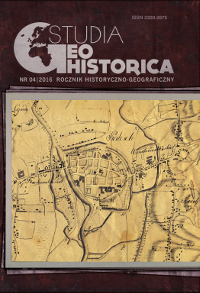Czym były mazowieckie "płozy"? (uwagi wstępne)
What were the Masovian “płozy”? (Preliminary Remarks)
Author(s): Elżbieta Kowalczyk-HeymanSubject(s): Cultural history, Historical Geography, 15th Century, 16th Century
Published by: Polskie Towarzystwo Historyczne
Keywords: granica;Mazowsze;płozy;onomastyka;borders;Mazovia;płozy;onomastics;
Summary/Abstract: 15th–16th century German, Latin, Polish and Russian descriptions of northern and eastern borders of Masovia, as well as descriptions of proprietary boundaries of what later became the Podlessian voivodeship, make repeated mention of the term polish płozy. It appears that płozy were a type of boundary markers, whose essence was at that time commonly understood; what is more, no linguistic equivalent for płozy seemed to existed in Russian, German or Latin. In the oldest mention of the term (early 15th century), płozy appeared as a proper name denoting a Polish equivalent for the German term describing a military road which was trodden by the Teutonic Knights in their expeditions to Lithuania, and probably, too, by Lithuanian forces fighting against the Knights. Significantly, the road ran across forests nearby the Masovian- -Teutonic border. It is quite plausible that the traces of the name of the road (płozy) have survived in the name of the village of Płozy (German Plosse, Plohsen), located on the left bank of the river Wałpusza (left tributary of Omulwia, and right of Narew), some 3.5 km from Szczytno, where the frontier Teutonic castle stood, the prosecutor’s seat. The term płozy has not been noted in any Polish language dictionary, nor has it appeared in Polish expert literature on setting borders and boundary markers. In this context, the present article attempts to explain the etymology of the term in reference to several words: płosa – meaning ‘farmland, patch of land, belt’; plos, ploso – ‘site with a pool of clear water on an overgrown swamp’; płaz, płóz – ‘amphibian, reptile’ and also ‘smooth side’ (e.g. of a sword); the verb płazić, płozić – ‘crawl’; and nouns płoz, płoza – ‘sleigh, sledge’. Moreover, it cannot be ruled out that what also influenced the emergence of the term was the method of determining the boundary lines. The above-quoted mentioned have allowed us to interpret płozy as a boundary marker, a patch of land devoid of trees or shrubs, cut out deep in the forest or set aside as fallow lands. It had to be broad enough to have roads running on it; alternatively, it could be ploughed in order to increase one’s acreage of owned lands which however resulted in shifting the boundary line. Further investigations will aim at determining whether the term płozy as a boundary marker and subsequently as a road was used exclusively in Masovia and territories inhabited by Masovians, or whether it was applied also in other regions of Poland.
Journal: Studia Geohistorica
- Issue Year: 2016
- Issue No: 4
- Page Range: 27-37
- Page Count: 11
- Language: Polish

